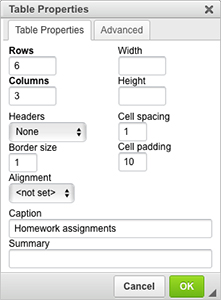Question: How do I control the way a table looks?
Answer:
When you first create a table the Table Properties window will appear.
Afterwards, you can change table settings by right-clicking on the table and choosing Table Properties. You can also change the number of rows or the number of columns with other right-click choices. See How do I insert and delete rows and columns? for details.
In the Table Properties window, you will usually want to adjust the settings on the Table Properties tab. We don't use any settings on the Advanced tab.
| Setting | Default value | Recommended value | Description |
|---|---|---|---|
| Rows | 3 | as many as you need | The number of rows in the table, including heading rows. |
| Columns | 2 | as many as you need | The number of columns in the table, including left-side "heading" columns. |
| Headers | None | If your table has one heading row and/or one heading column, pick First Row or First Column or Both. This causes the cell contents of that row and/or column to be bold and centered -- as you see with the table this sentence is in. Otherwise, leave it set to None. | |
| Border size | 1 | 1 | The thickness of the lines around the outside of the table. Specify 0 for no borders (in which case you'll still see very light lines while editing but the published page won't have any lines). Specify a small integer for thicker borders. |
| Alignment | <not set> | Left or Center | The choices are <not set>, Left, Center, and Right. This determines where your table appears within the text area. Normally you should choose <not set> to left-justify the table or Center to center it left-right. We don't recommend setting Alignment to Left or Right, which makes the table appear directly to the left or right of other text in the rich text element, with no space in between. This usually makes the result hard to read. If you use either of these settings, it will help to set Border size to 0 and Cell spacing to at least 10. |
| Width | 100% | blank | The default of 100% will cause the table to fill the full width of the column it's in, whether it needs the space or not. In most cases, setting the Width to blank will produce a better-looking table where the table content "just fits." You can also specify an exact width, e.g., 500px for 500 pixels, but we don't recommend this. |
| Height | blank | blank | An exact height for your table, e.g., 100px for 100 pixels. You should leave this blank. |
| Cell Spacing | 1 | 0 | The "gutter" space betwen rows and columns. Specify 0 for the thinest possible spaces between cells. |
| Cell padding | 1 | 10 for spacious tables and 5 for tables with tighter spacing | The margins around the content of each cell. Tables with 0 cell padding and a non-zero border are crowded and hard to read. |
| Caption | blank | blank | A title that will appear above the table on the page. It's a good habit to fill this in because it helps people who are visually disabled and use "screen reader" software. |
| Summary | blank | blank | A short summary that will be stored in the web page but not displayed by default. Some web browsers display the summary message when you hover over the table. We usually leave this blank. |
